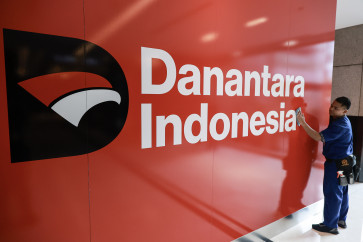Popular Reads
Top Results
Can't find what you're looking for?
View all search resultsPopular Reads
Top Results
Can't find what you're looking for?
View all search resultsKey to Jakarta's floods: Basin flood management
Flooding is an annual event in Jakarta during the wet season, and the flooding has become more devastating recently
Change text size
Gift Premium Articles
to Anyone
Flooding is an annual event in Jakarta during the wet season, and the flooding has become more devastating recently. Even the turnprike to Soekarno-Hatta International Airport was recently flooded.
Several areas in northern Jakarta, located near the coast, were inundated for several weeks in the last few months, according to media reports.
It seems the government is not serious in its attempt to reduce the flood risk because flooding is widespread and has become more devastating. Yet, communities living in flood prone areas have become accustomed to flooding.
The flood problem in Jakarta is complex, and needs a comprehensive approach to solve it.
According to Andjelkovic (2001), flooding is caused by extreme natural events occurring within a drainage basin, also referred to as a river basin, a catchment area or a watershed.
Drainage basins can be rural and urban, and, therefore, flooding can be rural and urban.
The implementation of flood management for urban areas is not the same for rural areas, because the characteristics of urban and rural areas are significantly different.
Jakarta is located in the downstream area of the Ciliwung River basin, and is affected by the characteristics and conditions of the upstream area. Furthermore, Jakarta is an urban area with complex socio-economical problems indirectly contributing to triggering a flood event.
Jakarta's population density has increased rapidly due to a growing urbanization rate, increasing the risk of floods.
Urbanization has many definitions. One of the more simplified definitions says urbanization is a process of artificial land use alteration occurring through time. Artificial land use alteration, due to population density increase in urban areas, converts pervious natural surfaces to impervious artificial surfaces, such as human settlements, transportation infrastructure and shopping centers.
The decreasing infiltration capacity and natural water storage capacity of the soil, due to the conversion of natural surfaces to artificial surfaces, increases the storm-water runoff rate and the total runoff volume, shortens the runoff travel time, reduces groundwater recharge and base flow, and increases peak runoff rate, leading to flood control problems.
Urbanization also increases wastewater and waterborne wastes, raises water demand, deteriorates water quality, and leads to pollution control problems.
Flooding in Jakarta is not only affected by changes in land uses, but is also caused by some factors such as long-lasting moderate rainfalls saturating the soil, inadequate land use, channelization of natural waterways, surcharge due to blockage of drains and street inlets, inflow from the river during high stages into urban drainage system, conversion of floodplain to human settlement, and domestic solid waste thrown away in the river.
Furthermore, urban flooding is not only affected by climate, but also affected by social, economical, cultural and technical factors. Therefore, a multidisciplinary approach to integrated flood management (IFM) is needed to reduce the flood risk.
Traditionally, flood control has been reactive focusing on structural measures and has been mono-disciplinary in nature.
Recently there has been evidence suggesting structural measures have disturbed the ecological balance. Therefore, it is widely recognized a paradigm shift is required to move from defensive to proactive action.
According to Global Water Partnership (GWP, 2006), the IFM approach aims to maximize the net benefits from flood plains and at the same time reduce the loss of life caused by flooding, flood vulnerability and risks, and preserve ecosystems and their associated biodiversity within the overall framework of integrated water resources management (IWRM).
Associate Program on Flood Management (APFM, 2007) reported a close relationship between water resources management, river management, land use management, forest management, erosion control, agriculture, urban drainage and sewerage within a river basin.
If the characteristics of the catchment changes, it will influence the characteristic and magnitude of the flood regime.
In some cases, flood management measures may impact the magnitude of floods downstream, transferring the flood risks. Therefore, flood management measures should take account the entire basin from upstream to downstream, and strategy for flood risk reduction should be realized through a basin flood management plan.
According to APFM (2007), the basin flood management plan presents a clear picture of the causes and effects of floods. The objectives of the basin flood management plan are to protect life and property from flood risks and enhance socio-economic development in a basin through IFM.
Data is required before arranging a basin flood management, according to APFM (2007). This includes meteorological data, hydrological data, geomorphologic data, environmental data, land use practices in the catchment including flood plains, pattern of human settlements in and around flood plains, demographic profile of flood plain inhabitant, infrastructure in the flood plains, future development plan in the basin and socio-economic damages in past floods.
A successful project requires stakeholder participation. The experiences of some developing countries, regarding water-related projects, shows stakeholder involvement had an important role in building partnerships and a sense of ownership (World Bank, 2004).
APFM (2007) reported stakeholder participation promotes individual and community ownership, commitment, and helps the sharing of risks among various entities.
Stakeholders involved in arranging a basin flood management plan could include local governments, water resources management boards, NGOs, departments of public works, local universities, community representatives, departments of forestry.
In the case of trans-boundary river basin such as Ciliwung river basin, the national government and related local governments should be involved.
A river gives benefits for the upstream inhabitant as well as downstream, and the upstream characteristics influence the downstream. Therefore, the basin should be managed integrally involving all stakeholders in the basin.
The writer is a lecturer at the Civil Engineering Department, Muhammadiyah University, Surakarta. She is an alumni of Water, Engineering, and Development Centre (WEDC), Loughborough University, England.










